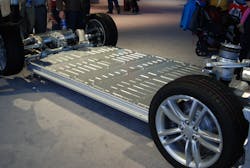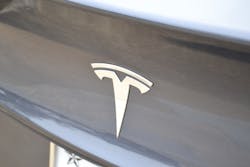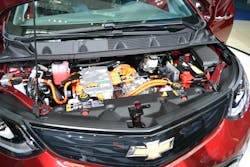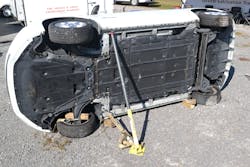University of Extrication: Electric Vehicle Extrication—Badging & Batteries
Topic: Electric vehicle (EV) identification and rescue/extrication challenges
Objective: Revise EV extrication protocols to address EV challenges
Task: The rescue team shall revise its scene size-up procedure to include information from sources other than vehicle badging and shall have extrication procedures planned when a floorpan-mounted high-voltage battery is present
What are referred to as electrified passenger vehicles, such as various hybrids (HEVs) and electric vehicles (EVs), are emerging as a unique challenge to responders at crash or fire scenes. Responders have encountered hybrid vehicles at incidents since early 2000 and have dealt with a multitude of HEV crash, extrication and, even, fire suppression scenes seemingly without major problems. Hybrids do pose some special challenges, but EVs require another level of size-up precision that involves model identification and floorpan-mounted batteries.
Badging
Responders must realize how critically important that it is when they arrive at a traffic collision or vehicle fire scene to identify the type of vehicle that’s involved: an internal combustion engine (ICE) vehicle, an HEV (or plug-in hybrid, or PHEV) or an EV (or extended range EV, or EREV). This sets the stage for the strategy and tactics that ensue.
With the scene size-up process in mind, past experience shows that responders rely on a vehicle’s exterior markings, or badging, to indicate the make and the model of the vehicle that’s involved.
With new model EVs, exterior badging can be on two sides, three sides or all four sides of an automobile. (The Volkswagen e-Golf and the Audi e-tron, both EVs, have badging on all four sides.)
Here is an important and brief reality check for responders about the vehicle badging that you see—and many times seem to take for granted—at an incident scene. Badging on a vehicle isn’t required. It’s done at the discretion of the vehicle designers and manufacturers. No U.S. requirements, international regulations or Society of Automotive Engineers (SAE) standards require or regulate vehicle badging. To make matters worse for U.S.-based first- and second-responders, SAE’s recommendations for badging in its J2990 document allow “unique” nameplates. It’s apparent that badging on the latest generation of EVs and on future EVs is trending toward this unique-badging free-for-all design style. For example, responders soon will have to recognize that the words “PEAR” and “OCEAN” on the exterior of a passenger vehicle will indicate an EV passenger vehicle from Fisker.
Rescuers who respond to crash incidents that involve models of EVs from Tesla must know that automaker’s corporate badging at front and rear—the corporate “T” logo—only indicates the manufacturer’s identity. This means that there is no badging on the vehicle that indicates the specific model: Model 3, Model S, Model X or Model Y. This a problem for rescuers when it comes to following the manufacturer’s recommended shutdown procedures.
To survive the onslaught of the unique-badging trend, you must rely less on exterior badging and revise walk-around size-up procedures to include additional potential sources of vehicle information. For example, responders might find that the vehicle identification number (VIN) and license plate data might become more important and increase in value as these individuals try to at least determine the model of vehicle.
In the same vein, the lack of an exhaust system, tailpipe or catalytic converter indicates an EV. Although finding the automobile plugged into a charging cord or at a public charging station is another good clue about what you are dealing with, the model of vehicle still might elude you.
The occupant might be the owner of the EV and, if uninjured, might be a good source of information about the vehicle: at least, the model of vehicle.
A few automakers, including General Motors, Mercedes-Benz and Toyota, apply stickers to the inside of filler doors, the edges of B-pillars or under the hood, among other locations, to assist responders in fulfilling safety procedures. If the sticker contains a QR Code, scanning that with a smartphone or tablet will reveal the vehicle’s Rescue Sheet. That details the make and model of the vehicle and provides a multitude of other vitally important responder information.
Additional size-up indicators include orange cables or connectors, which are most visible under the hood. Orange is required in the United States for systems that carry current that exceeds 60V d.c. If you raise the hood and see orange cables, connectors or a cable sheath, report that to your on-scene officer-in-charge. There is high voltage somewhere.
A front storage area that’s under the hood might be a frunk. This additional cargo-carrying space on several EVs exists because there is no ICE. All frunks indicate an EV, but not all EVs have a frunk. Still, the exact model of vehicle might remain a mystery even when the vehicle has a frunk.
Exterior cover doors are a new item to include in your walk-around size-up process. In this author’s opinion, they are one of the most important additions to our size-up process to date. If a responder sees one small cover door on a fender, for example, the vehicle could be an ICE or an EV. Open the small door to see what’s there. A hollow tube indicates that the vehicle takes a liquid fuel—hence, has an ICE. A receptacle under the cover door for a charging cord indicates either a PHEV, an EV or an EREV.
Because of the lack of any requirements or standards, charging port cover doors on the latest EVs are, essentially, hidden from view. Consumer appearance preferences along with aerodynamic designs make these important size-up indicators less and less visible. EVs can have their charging port cover doors designed into their taillight assemblies (Tesla), front grill logos (Audi) or rear bumpers (Mercedes-Benz), or the cover door might consist of a movable panel that’s along the edge of a front wheelwell (Rivian).
Floorpan-mounted batteries
Responders to the scene of an EV crash must consider that the high-voltage battery most likely utilizes a lithium-ion chemistry and that, being of a large size, most likely is mounted beneath the floorpan of the vehicle. This location retains occupant legroom and storage space, but for rescuers, a heavy battery low in the structure of the vehicle completely throws off the vehicle’s center of gravity/center of mass.
When a four-door EV sedan has a total weight of some-4,000 lbs. and potentially 1,200 lbs. of it is the lithium-ion battery that’s beneath the floorpan, the vehicle will be found to be very bottom-heavy. Stabilization will be a challenge for rescuers when the vehicle is in a roof-resting or side-resting position.
Types of Hybrids & EVs
- Hybrid (HEV)
- Plug-in Hybrid (PHEV)
- Electric Vehicle (EV or BEV)
- Extended Range Electric Vehicle (EREV)
About the Author
Ron Moore
RON MOORE, who is a Firehouse contributing editor, recently retired as a division chief with the McKinney, TX, Fire Department and now serves with Prosper, TX, Fire Rescue. He self-published the Vehicle Rescue 1-2-3 training manual and serves as the forum moderator for the extrication section of Firehouse.com . Moore can be contacted directly at [email protected].





